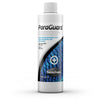Seachem Paraguard
DESCRIPTION
ParaGuard™ is the only fish and filter safe aldehyde based (10% by weight) parasite control product available (for parasites on fish). Unlike highly toxic and difficult to use formalin based medications, ParaGuard™ contains no formaldehyde or methanol and will not alter pH. ParaGuard™ employs a proprietary, synergistic blend of aldehydes, malachite green, and fish protective polymers that effectively and efficiently eradicates many ectoparasites (e.g. ich, etc.) and external fungal/bacterial/viral lesions (e.g., fin rot). It is particularly useful in hospital and receiving tanks for new fish and whenever new fish are introduced to a community tank.
TYPES OF INFECTIONS TREATED
| Parasitic | Fungal | Bacterial | Viral | |
|---|---|---|---|---|
| ParaGuard |  |
 |
 |
 |
DIRECTIONS
Dosing
Remove all invertebrates from the tank as well as any chemical filtration. Use 5 mL (1 capful) of ParaGuard™ for every 40 L (10 US gallons). Repeat this dose daily as required as long as fish show no stress.
ParaGuard™ can also be used as a medicated dip. For 1 hour dips, use 3 mL per 4 L (1 US gallon) in a container separate from your main tank. Dips may be extended if the fish show no evidence of stress. Keep in mind that many diseases linger in the water as well as on the fish. Giving a fish a dip treatment does no good if they go right back into infected water.
Quarantine
This is a tank set up in order monitor and medicate new fish before they go into the main tank. ParaGuard is gentle enough to use prophylactically (without visible symptoms) if needed. Quarantine times vary, but we generally recommend 2 weeks of treatment with ParaGuard™ to clear out any possible external infections.
Sensitive Fish
Some fish are more sensitive to medications than others. Eels, loaches, rays, sharks, and many others are well known for their sensitivity to all kinds of medications. If you suspect that your fish may be sensitive to medications, it is just fine to start with a partial dose and build up to the full dose over several days.
Not recommended for reef aquaria. As an alternative, use Seachem’s MetroPlex™.
COMMON FISH DISEASES TREATABLE WITH PARAGUARD
Ichthyophthirius (freshwater) / Cryptocaryon (saltwater)
Looks like salt sprinkled on the fish’s body and fins. Usually accompanied by twitching, flashing, and other signs of stress and irritation. Several parasites are grouped under this name, but the symptoms are almost identical. Ich is among the most common infections of fish, and is entirely treatable with diligence and attention to water quality.Suggested Treatment Period:
14 days in freshwater, up to 28 days in saltwaterSpecial Considerations
It is very important with this parasite to continue dosing for the full treatment period. A break in the medication allows the parasite to multiply and reinfect the fish.Piscinoodinium (freshwater) / Amyloodinium (saltwater)
Similar to Ich, but smaller and grey-gold. Most often seen in saltwater, but can occur in freshwater as well. Velvet is lessSuggested Treatment Period:
14-21 daysSpecial Considerations
Velvet is a photosynthetic parasite - it will help with treatment if you can turn off the lights while the fish are infectedBacterial infection
Fins appear shredded, frayed, or decaying. Fin Rot is frequently mistaken for damage from fin-nipping fish. Contrary to the name, this is actually caused by bacteria, not fungus.Suggested Treatment Period:
7 days or until infection clearsSpecial Considerations
Fin Rot is often found as a secondary infection (that’s an infection that started because the fish was already sick). Make sure to check for additional infections.Dactylogyrus trematodes (skin) / Monogenenean trematodes (gills)
Suggested Treatment Period:
14 days or until infection clearsSpecial Considerations
Dip treatments with ParaGuard™ are helpful in treating and preventing flukes, but keep in mind that this parasite spends part of its life cycle living in your water and substrate - the entire tank needs to be treated in order to clear the infection.THEY’RE NOT ALWAYS ON THE FISH!
Ich, velvet, and many other parasites spend a large portion of their life cycle as a cyst that is immune to medication and hiding in the substrate of your tank. Remember that you need to finish the full treatment even if you can’t see parasites on the fish any more!






